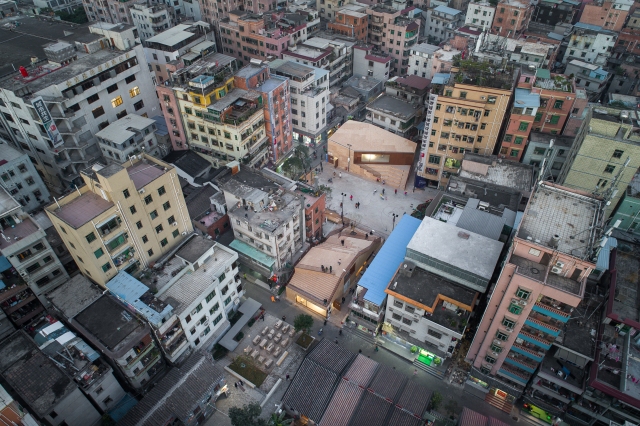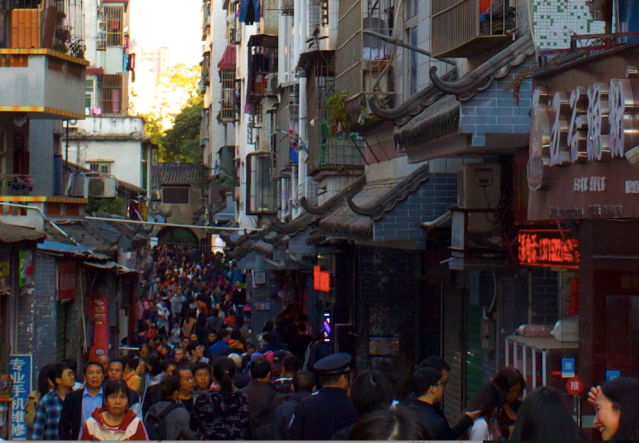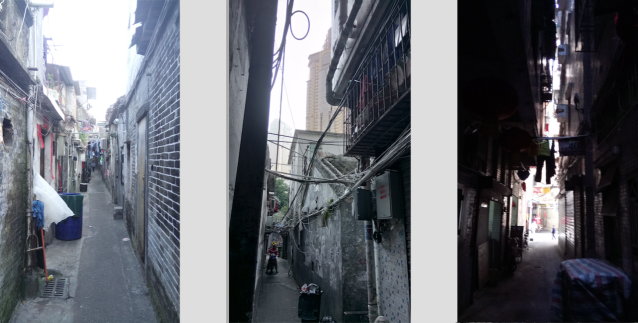Beyond China, Shenzhen is probably best-known for two things. It’s where iPhones and other gadgets that have transformed everyday life are made, and it’s the place which grew from a fishing village in 1980 into today’s futuristic megacity of 11 million — or at least, that’s the urbanist legend. For urbanists — those interested in how cities build up — few places are more fascinating. No other country has urbanised as rapidly or extensively as China, and it’s been Shenzhen that has blazed the new trail for all others in China. Those seeking clues to future cities find a vast dynamic laboratory there.
Between December 2017 and 15th March 2018, Shenzhen hosts an event called the Urbanist/Architecture Bi-City Biennale 2017, or UABB (not to be confused with the parallel but separate UABB Hong Kong).

Meng Yan of Urbanus. Photo Herbert Wright
‘In most of the city you see towers, shopping malls, theme parks, boulevards’ says Meng Yan, co-founder of Urbanus, an architectural practice based in Beijing and Shenzhen.‘But all of a sudden you see [what is] almost like a walled city, which contains smaller streets and is a very intimate scale and very vibrant’. He’s talking about urban villages — the central subject of UABB’s theme, Cities Grow in Difference. Its main exhibition is embedded within an urban village that is literally a walled city, called Nantou.
Meng contends that the urban village ‘reveals an alternative model of urban development [which] is self-sponsored, self-motivated, diverse’. That’s a big message not just for Shenzhen, but for a rapidly urbanising planet.

Nantou Old Town, looking down on new Baode Plaza. Courtesy UABB Organizing Committee
Shenzhen is full of urban villages. From above, they are easy to spot by their jumble of small-plot buildings. But from a main street, they are virtually invisible. They lurk behind great cliffs of high-rise housing or else a Blade Runner-like scenography of towers and facades alive with LED animation. Step off the big street and you can easily enter these hidden neighbourhoods. They are packed with eateries and small businesses, and the air is full of voices, smells and the honks of scooters. Warrens of alleys branch off, lined with ‘handshake buildings,’ so-called because in the tenements above, they are narrow enough for people to shake hands across the gap. The chasms they make can close off so much light that the street level is dark even by day.
Shenzhen’s urban villages tend to follow a similar history. Situated on the Pearl River Delta, the area has long supported agriculture and fishing, and settlements accumulated over centuries. In 1980, Chinese leader Deng Xiaoping designated Shenzhen a Special Economic Zone, to draw investment from Hong Kong, situated immediately to the south. Shenzhen offered land to build factories and waterside to ship goods, and China offered a virtually limitless cheap workforce. Within five years, the population had reached a million, and by 2000, seven million.
Indigenous villagers cashed in by embarking on a frenzy of unplanned construction on their small plots of land. They rented the rapidly-built new blocks to the influx of migrants flooding into the metropolis. Even when the rate of population growth slowed this century, Shenzhen continued to attract millions, and they all needed accommodation. This intense development to supply it made many original villagers rich enough to move out to Hong Kong or abroad.
In China, neighbourhoods can seem timeless, for example in the hutongs of Beijing. But others can age fast. Shenzhen’s newly urbanised villages soon became synonymous with poverty, overcrowding, unhygienic conditions, prostitution and crime. Meng reports that they were ‘almost unanimously thought of as a cancer and that it has to be dealt with’. In 2005, Shenzhen Municipality decided to demolish them all. Like planners and architects everywhere, from le Corbusier with his modernist Utopian city visions dreamt up in the 1920s and even earlier planners like Haussmann in Paris, their approach was to impose order on the environment and rebuild it big, with all its implications for social oder. Planners have long failed to respect or even recognise the dynamism that arises in the chaotic jumble of unplanned settlement. And in Shenzhen, the municipality has backed developers whose plans have been to buy out the villagers, many happy to take the undreamt-of incentives to move, bulldoze the urban villages they built, and ‘regenerate’ the land with schemes of high-rise apartments, landmark commercial skyscrapers, and glitzy malls. The logic was to provide what millions of new arrivals need from a city – modern housing, amenities and jobs — and simultaneously eliminate poverty.
UABB first suggested that there was more to urban villages than mere slums as early as 2005. Urbanus took their cause to the world stage at Shanghai Expo 2010, at which they curated the Shenzhen Pavilion. Its subject was Dafen, Shenzhen’s village famous for copying oil paintings. It showed ‘how a cancer was cured’, recalls Meng. ‘It was a very brave and very daring effort at that time’. Nowadays, Dafen is clean, colourful and popular with tourists.
Attitudes to Shenzhen’s urban villages may be changing but development pressures still threaten them with demolition by bulldozer. And recently, as Shenzhen has transitioned from manufacturing to an affluent services economy, a new phenomenon has emerged in the village — gentrification.
The Secrets of a Walled City Revealed
Nantou’s recent history is like that of many urban villages, but it has a unique asset — official protection. In 2002, it was designated a historical city. It is one of several villages in Shenzhen that has a far longer past than the modern metropolis.
Nantou pre-dates Deng with at least sixteen centuries of continuous habitation. In 331AD, it was made the capital of the vast Dongguan Province covering much of the Pearl River Delta. That lasted just 81 years, but it remained an administrative centre. In 1573 it became the capital of the new Xin’an County (later Boa’an County), and its territory again extended as far as what is now Hong Kong. After the Communists came to power in 1949, they transferred power away. For a while it became a quiet village, until the Deng-era of the 1980s when its population boomed again. In that decade, a factory complex was built on its northern side, making clothes. Its workforce was on its doorstep.

Zhongshan East Street, Nantou. Photo © Monique Kawecki 2017
On the surface, Nantou may not look that old. The urban village is a super-dense car-free neighbourhood with about 30,000 inhabitants in a grid of just 34 hectares. It is entered through grand fortress gates which were once set in a medieval defensive wall, little of which remains. There are a few relics of pre-modernity. Outside the South Gate is the Taoist Guanyu Temple, thought to date from the sixteenth century. There are a few old houses, temples and ancestral halls within the walled city. You can see Chinese roof eaves that maintain traditional forms, some with moulded face motifs capping their sloping ribs. They overhang twentieth century shop fronts on crowded Zhongshan East Road.

Aspects of past Nantou – Guan Yu Temple, South Gate, roof eaves. Photos © Herbert Wright 2017
But Nantou is mostly as old as the megacity that has engulfed it. Buildings on small plots that haven’t changed in centuries reach as high as nine storeys, often clad in tiles or mosaics that rain would wash clean. In the shady alleys between them, people sit on their front doors. On one walk, I passed a family burning a rat alive. Then, a mere minute’s walk away, I encountered Wu Ming, a young architect who studied in Turin. He may a harbinger of a new sort of arrival. He has rented a house and converted the ground floor into a trendy work/live space, which he was proudly showing during UABB. Referring to the traditional game that men gamble on, Wu explains that ‘the owner didn’t want it to be a mahjong room’. He reports that some of the neighbours are original, others have been here for 20 years. The national language Putonghua (Mandarin) is spoken in Shenzhen, but here, Ming reports, ‘the languages are different’.
Meanwhile, restaurants on Zhongshan Street South, the main path into Nantou from the South Gate, have been spruced up. The backlit word ‘Villa’ in Western letters is mounted on a posh-looking five-storey building. The inevitable outcome of gentrification is to price out local residents. Still, some consider other problems more urgent — Zhou Baomin, Director-General of Culture and Sports Bureau of Nanshan District, the local authority, brings up issues like fire safety and plumbing — in Nantou, he says, ‘everything is under pressure’.
How to Help an Urban Village
Nantou gave the UABB chief curators Meng and Urbanus co-founder Xiadou Liu, along with the third chief curator Hou Hanrun, artistic director of MAXXI, Rome, a chance to show what positive intervention in an urban village can do. It helped that there was a base for them there — that factory, now abandoned. Conversations started with the locals, initially for research and documentation purposes. But it was also consultation on UABB’s plans, including local cultural initiatives, for example with dance. Then UABB began changing the built environment — with an absolute minimum of demolition.
When the show leaves town, it leaves legacy. Murals brighten walls, historic buildings have been renovated (an opium den has become a visitor attraction), and public spaces created. All interventions were made in the urban fabric without disrupting it. The best of these are at the very geographical centre of Nantou. UABB leaves two new angular community buildings, each striking yet discrete, with mosaics and terraces which face Boade Plaza, which is a new public space that has been opened up. It is like a breathing space in the dense urban fabric. In UABB’s opening month, it was already as full of civic activity as if it had been the central plaza for centuries.

Boade Plaza in Nantou is a legacy of UABB. Photo courtesy UABB Organising Committee, 2017
Within the factory, further public realm has been opened up, and facilities including a new auditorium and an open bamboo pavilion inspired by traditional vernacular. The factory itself is temporarily the main UABB exhibition venue, where a cornucopia of research, analysis, art, installations and photography is presented. One of the key exhibitions is by Juan Du, director of Urban Ecologies Design Lab at Hong Kong University — a documentation of Shenzhen’s urban villages that have deep history. Nantou is not the only one to pre-date the megacity.
Ancient Before Birth – Shenzhen’s Deep History
Shenzhen’s historic urban villages include Baishizhou, established in 1830, and now home to 150,000. Its very size and vibrancy has attracted international attention before. Like Nantou, it lies in Nanshen, one of Shenzhen’s three core districts (the equivalent of boroughs). On the other side of middle district Futian is the third one, Luohu. There, history connects with the metropolis whose proximity and riches kick-started modern Shenzhen — Hong Kong.
In October 1911, Imperial soldiers of the Qing Dynasty stood in line on a platform as a steam locomotive festooned with flags pulled into the newly-opened station of Shum-Chun. This was the first stop on the Chinese side of the Kowloon-Cantoon Railway (KCR), and it stood amongst tranquil fields beside the river that separated British and Chinese territory. Now, the station is modern, vast, and called Shenzhen.
But it is the next stop on the KCR that again exposes the legend of Shenzhen’s explosion from a fishing village as less than the truth. Its name, Shum-Chun Market, referred to the 700-year old market town of Caiwuwei nearby. It became famous in 2007 for its ‘nailhouse’, a term used to describe Chinese houses that persist when a site has been cleared for redevelopment, because the owner has refused to sell or be intimidated.

Islands of super-dense housing in Caiwuwei, from KK100. Photo Herbert Wright 2011
Now it is the site of the 442m-high KK100, Shenzhen’s tallest skyscraper when it opened in 2011. From its breath-taking top-level skylounge pavilion floating under the great gothically arching glass roof, you can look down on Cauwuwei’s street patterns and the fine urban grain of rectangular roofs crowded together like a not-quite straight mosaic. Their pattern suggests a palimpsest of what was there before.
On the other side of the KCR tracks lay Hubei. Juan Du’s research suggests there are still 1,500 indigenous villagers amongst the population of 20,000, and streets of original one-storey housing remain. I walked through the small, ancient gate into these lanes. Smoke from burning offerings in the old temple hangs in the air and messy electric wiring trails across scruffy processions of closed brick facades. In these alleys, a timeless poverty seems to linger, but an adjacent alley is the timeless activity of traders working in open-fronted stores. To the north, Hubei has modest, tidy twentieth century socialist housing blocks where planners found a patch to build, but then they give way to some of the deepest, darkest alleys in Shenzhen. All of Hubei is surrounded by skyscrapers, including the sheer bling that is Golden Business Center’s 220m-high tower. Urbanus proposed preservation in 2014, but the Luohu Urban District Renewal Bureau recently updated its Hubei redevelopment plans.

Three alleys in Hubei urban village. Photos © Herbert Wright 2017
Let A Thousand Urban Villages Bloom
Shenzhen may be churning its organic, unplanned neighbourhoods into super-sized commercial developments faster than most cities, but it’s a global phenomenon and the result looks increasingly the same the world over. Meng thinks that ‘it’s really important to rethink and reflect the modernist ideal of uniformity, [the] monumental kind of model of future’. The unplanned urban village suggests a different path.

Planned and Unplanned – Futian from Shenzhen Civic Center, and a typical Nanshen neighbourhood. Photos © Herbert Wright 2017
Worldwide, we can see unplanned urbanism go through the stages that Shenzhen’s urban villages have. In developing nations, from vast slums to constrained ghettoes, their poverty seems intractable, but sheer industry and the bonds of community can raise them up into thriving neighbourhoods (Dharavi in Mumbai with its million people is often cited as an example). If an urban village thrives, it may become middle class, and gentrification may set in. Ultimately, as you often see in great developed cities in the West, the very village character is lost to a completely commercialised or even disneyfied pretence of an urban village — it becomes a shopping, dining or entertainment ‘lifestyle’ experience just for visitors.
Intervention can sustain and safeguard the precious vitality of the urban village, but it must differ according to location, as well as which stage in its evolution the neighbourhood has reached. Sanitation may be a life-and-death issue in one place, keeping chain retailers at bay may matter in another. The UABB lesson is that whatever the situation of an urban village, the starting point is to engage with the villagers. UABB crafted a tailored response to Nantou, but it had satellite locations in other urban villages as well. For example, in a semi-rural village at the edge of Guangming in the far north of the Shenzhen, with very different challenges to inner-city villages, UABB’s intervention was about equipping an ageing community with confidence and facilities to endure as change comes with a new metro line.
There’s a lot to learn from urban villages. Big-time developments follow a global blueprint, but the urban villages had no blueprint. They are sustainable and vibrant while staying local – and each is different. In Shenzhen, every time an urban village is lost, another chapter of its true history is deleted — not just of the breakneck, unconstrained Deng-era growth, but often, the ghosts and traces of far earlier times. And just as in any city, when an urban village goes, its host city loses part of its soul.
More of the interview with Meng Yan on CoBo Social, January 2018. Blueprint publishes my review of UABB Shenzhen March 2018
